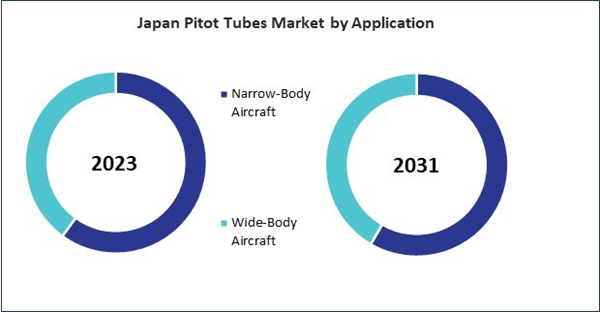The China market dominated the Asia Pacific Pitot Tubes Market by Country in 2023, and would continue to be a dominant market till 2031; thereby, achieving a market value of $32,520.8 Thousands by 2031. The Japan market is registering a CAGR of 6.5% during (2024 - 2031). Additionally, The India market would showcase a CAGR of 7.9% during (2024 - 2031).
Materials science, aerodynamics, and sensor technology advancements have revolutionized the market. Traditional pitot-static systems have evolved into more robust and accurate designs, featuring advanced materials like titanium and composite alloys to withstand harsh environmental conditions. Additionally, integration with digital avionics systems has enhanced data processing capabilities and reliability.
Various trends, including increasing demand for fuel-efficient aircraft, rising air passenger traffic, and stringent regulatory requirements, influence the market. There is a growing adoption of advanced pitot tube systems that are equipped with features such as self-diagnostic capabilities, anti-icing mechanisms, and compatibility with emerging aircraft platforms like unmanned aerial vehicles (UAVs) and electric aircraft. This is due to the fact that the aviation industry is placing a greater emphasis on safety and efficiency.
Several factors, including the significant growth in air travel in countries like India and China, drive the expanding market in the Asia Pacific. In India, domestic airlines registered an annual growth rate of 36.10% in passengers carried, reflecting a substantial increase in air travel demand. Similarly, China's civil aviation sector is experiencing sustained and rapid development, with more than 57.3 million air passenger trips recorded in January 2024, representing a surge of 44.1% year-on-year. Thus, the expanding market in the Asia Pacific is driven by the growth in air travel in countries like India and China and the significant maritime activity in the region.
Based on Feature, the market is segmented into Heated, and Unheated. Based on Type, the market is segmented into S Shape Pitot Tubes, L Shape Pitot Tubes, and Others. Based on Application, the market is segmented into Narrow-Body Aircraft, and Wide-Body Aircraft. Based on countries, the market is segmented into China, Japan, India, South Korea, Singapore, Malaysia, and Rest of Asia Pacific.
List of Key Companies Profiled
- AeroControlex Group, Inc (TransDigm Group, Inc.)
- Thales Group S.A.
- Tokyo Aircraft Instrument Co., Ltd. (KODEN Holdings Co., Ltd.)
- Dynon Avionics
- Honeywell International, Inc.
- Aeroprobe Corporation
- Collins Aerospace (RTX Corporation)
- The Boeing Company
- Textron, Inc.
- Yokogawa Electric Corporation
Market Report Segmentation
By Feature- Heated
- Unheated
- S Shape Pitot Tubes
- L Shape Pitot Tubes
- Others
- Narrow-Body Aircraft
- Wide-Body Aircraft
- China
- Japan
- India
- South Korea
- Singapore
- Malaysia
- Rest of Asia Pacific
Table of Contents
Companies Mentioned
- AeroControlex Group, Inc (TransDigm Group, Inc.)
- Thales Group S.A.
- Tokyo Aircraft Instrument Co., Ltd. (KODEN Holdings Co., Ltd.)
- Dynon Avionics
- Honeywell International, Inc.
- Aeroprobe Corporation
- Collins Aerospace (RTX Corporation)
- The Boeing Company
- Textron, Inc.
- Yokogawa Electric Corporation









